The Story Behind the Making of Our First Digital Storybook
Christina Martidou, Greece
Christina Martidou has been an English teacher for the past 13 years. She has a degree in ‘English Language and Literature’ from the Aristotle University of Thessaloniki and an MA in ‘Media, Culture and Communication’ from UCL, Institute of Education.
She has worked both freelance and in private schools with students of various ages and levels. She has a genuine interest in educational technology and more specifically the integration of Web 2.0 tools, social media and digital games in foreign language teaching. She’s currently based in Thessaloniki, Greece.
E-mail: martidouchristina@gmail.com
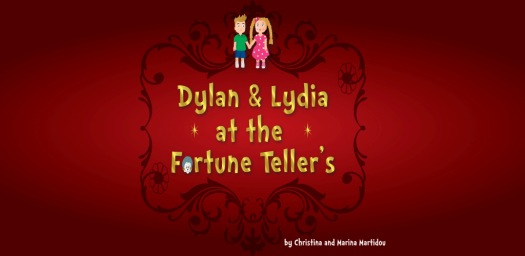
Menu
Introduction
The plot in brief
How it all started
Why a digital storybook?
Making of…
Challenges along the way
Some trivia
Recent news
Conclusion
I’m very excited to be sharing the story behind the making of our first digital storybook for YLs of English (aged 9 and above). ‘Dylan and Lydia at the Fortune Teller’s’ was recently released both on the App store& the Play store. In short, it is a highly interactive, double-path story packed with:
- delightful illustrations
- enchanting background music
- engaging audio narration
- multiple reading modes: Read to me- Read it myself and Record my voice
- charming animations, surprise features & sound effects within each page.
- enjoyable ELT activities
- in-built dictionaries
- fun story-based games
On a day trip to London the endearing 9-year-old twins, Dylan and Lydia, meet Madame Sonya, a famous fortune teller who slyly tries to trick them into her evil plans. The twins have the chance to experience magical moments in ‘Fantasy Land’ or spend an adventurous day with notorious pirates on a real pirate ship! Both adventures teach them important life lessons about the value of true friendship and trust. You can take a slight idea from the promo video below:
www.youtube.com/watch?v=XN2tG34RPi8
My sister Marina and I have always loved fairy tales and until today we’re big fans of Walt Disney! Writing and publishing our very own children’s book was one of our childhood dreams. Feeling a great need to be creative in a time of deep financial crisis, we came up with Dylan and Lydia’s adventures last spring on a ship to Corfu- a beautiful island in the Ionian Sea.
Who doesn’t love a good story? A well- told tale can fascinate, grip and engross us in a fictional world no matter how old we are. Both children and adults are drawn to stories in a natural, effortless way. In effect, the pedagogical values of storytelling are unparalleled. It’s the oldest form of education and a fabulous tool in teachers’ hands. Albert Einstein’s quote beautifully describes the unique powers of storytelling: ‘If you want your children to be intelligent, read them fairy tales. If you want them to be more intelligent, read them more fairy tales.’

Stories can have a profound impact on foreign language learning too. They are motivating, fun and provide a low anxiety context for language learning. Teachers can exploit stories to introduce or revise new vocabulary, grammar rules, and language patterns as well as to engage students meaningfully.
Digital storybooks are the ‘new generation’ of fairy tales. They combine the multimodal nature of new technologies (text, visuals, audio, music and animations) and the valuable linguistic and psychological features of storytelling. This much promising ‘marriage’ reflects the digital age we live in and is bound to open up new paths in educational practices worldwide.
‘Dylan& Lydia at the Fortune Teller’s’ was created with this rationale in mind. It aims to address the needs of the 21st language learner by offering EFL teachers a brilliant chance to teach English through the lens of storytelling and technology! It can help boost young learners’ language proficiency, spark their imagination and engage them in extensive reading.
The journey from the initial grasping of this idea until its final completion has been wonderful yet sometimes overwhelming! By no means, could we imagine the amount of work and devotion needed when we first ventured into this project.
One of the first things we did was an extensive research on the ELT market for similar products. We also read numerous digital storybooks to spot their main features compared to traditional print fairy tales. Next, we planned the basic structure of the storybook and I set out to write the stories in English as well as design the accompanying activities and games.
Our main aim was to develop an educational App that would combine learning and entertainment seamlessly. For this reason, the storybook includes multiple choice questions, an imaginative writing activity, two in-built dictionaries and a glossary. The reader can then have fun while making sliding puzzles or matching pairs with 3 levels of difficulty. What’s more, 2 mini games (a hidden objects game & a knowledge quiz) are an integral, contextualized part of the plot. In this way, the reader is involved in the action and the overall reading experience becomes more interactive, fun and engaging.
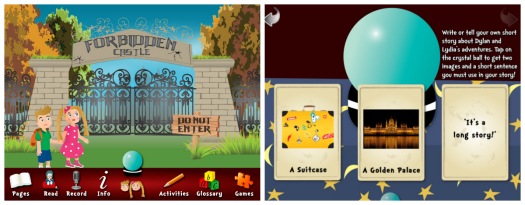

Unlike conventional linear novels, we thought of writing two stories instead of one, with different endings and morals. So, when Dylan and Lydia are in Madame Sonya’s caravan, the reader can choose the direction of the story in the role of the protagonists and create his own reading path.
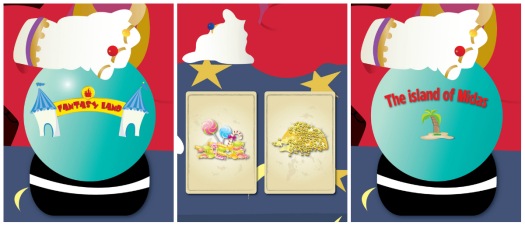
From a pedagogical scope, the tales have been written in simple yet not oversimplified English both in terms of vocabulary and grammar. The repetition of words and lexical sets along with the two dictionaries contribute to learning and content understanding. Delightful illustrations complement the text and make it easier for less fluent students to understand and follow the story. The user can hear the story read aloud or record his own voice narrating and play it back! This helps improve both his listening and diction skills.
It’s a well-known fact that language learners’ exposure to different accents and voices is beneficial. So, two great colleagues and native speakers of English, Edmund Dudley and Esther Martin, have lent their voices to this fairy tale. The roles of the main characters have been narrated by students of ours (non-native speakers). In this way, when students read the stories, they can relate to other fluent young learners of English.
As for the graphics, we experimented a lot in order to make our characters appealing to young children. The outfits and the overall style of the protagonists have been carefully chosen. We have mainly used bright and joyful colours except for the screenshots at Madame Sonya’s caravan where we wanted to add some extra sense of mystery. Every screenshot has been designed in detail and there are many interactive elements and surprises for the learner to discover.
Most importantly, English language learners have been part of this creative process from day one. We had all the materials (texts, graphic designs, games& activities) tested by 9- 12 year old students (boys and girls) from different backgrounds and language levels. Their feedback was invaluable and we actually implemented many of their ideas.
A very common problem with children’s stories written for language learning purposes is the dumbing down of the texts which unavoidably leads to their loss of magic! Therefore, achieving a suitable language level for learners worldwide without sacrificing our stories’ magic was by all means one of the most serious challenges I had to face. Being used to teaching Greek students who usually acquire a high level of English from an early age, my first drafts were pretty advanced. So, I used the valuable help of Hanna Kryszewska and Charles Boyle to grade down the original texts appropriately. Here is just a short sample of the first draft and its final adaptation.

The second biggest challenge was the recording of my students’ voices. To ensure the high quality of sound, we visited the professional recording studio where my sister broadcasts her radio show on a daily basis. My students were more than happy to participate and were thrilled to visit a recording studio! However, they were a bit intimidated by the microphone at first. The tricky part for us was to achieve a satisfying level of performance (good pronunciation and acting) without losing students’ spontaneity by having them repeat their lines again and again. Luckily, with a little encouragement, the recordings were completed successfully. Here are some pictures from the studio:
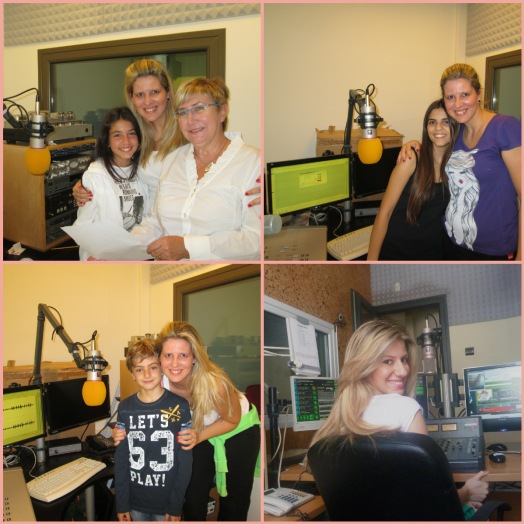
- Madame Sonya was initially drawn by my sister Marina when she was in high school! While sorting out old stuff, we came across the drawing and decided to craft a story around this mysterious white cat ;-). Look at the following collage and see how the drawing was adapted by the graphic designer to fit the overall look of the storybook.
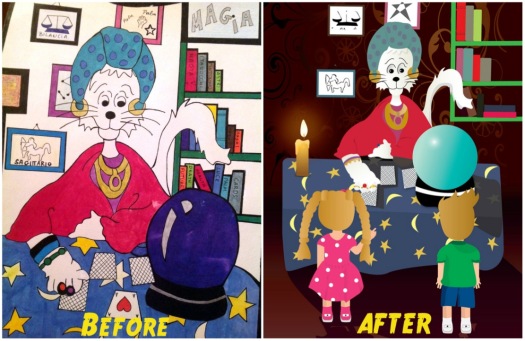
- This collage shows how we experimented with the appearance of our main characters to make them appealing for our young target audience:
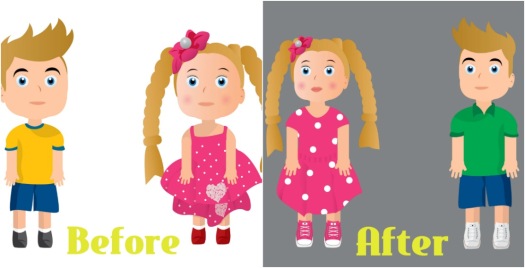
- The charming music that comes with our storybook is royalty- free music that we found on the Internet. The artist Kevin MacLeod offers a big number of pieces that can be used for educational purposes under a Creative Commons license. Visit his website here: http://incompetech.com/music/royalty-free/
- When my sister recorded Madame Sonya’s lines, she was 9-months pregnant!
Seeing the project being completed piece by piece and our characters come to life has been a truly unique experience! With the help of dear colleagues and the participation of enthusiastic English language learners, our personal dream has come true! We’d like to thank each of them wholeheartedly for their invaluable contribution.
I’m happy to announce that ‘Dylan& Lydia’ has so far been downloaded by 12.000 users worldwide. Additionally, it was implemented by a dear colleague and friend, Rania Chiotini, in a public school in Chios- an island located in the Eastern Aegean Sea. Although the school is not a fully-equipped one, Rania connected her iPad to the classroom’s projector. Quoting Rania’s feedback: ‘Students vastly enjoyed the stories of Dylan and Lydia. They loved the characters, empathized with them and got hooked on the activities and games. It was a unique learning experience that gave both me and my students the chance to enrich our syllabus and integrate technology effectively in our class.’
Here are some pictures that Rania sent me:
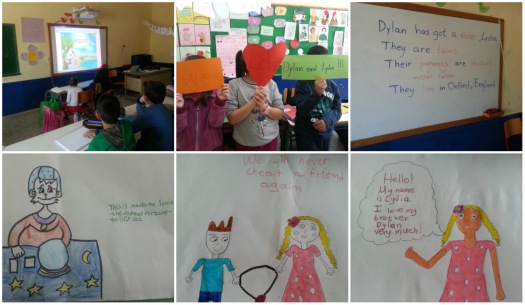
We really hope that our stories will keep touching the hearts of young English language learners all over the world and make language acquisition a fun, hands-on experience!
Please visit the App store here: http://bit.ly/1pzv6O8 and the Play store here: http://bit.ly/1jzu9RL to install and read our storybook. We’d be delighted to receive your and your students’ feedback! You can also like our FB page here: http://on.fb.me/1loXTN8 for updates and supplementary teaching materials.

Please check the Methodology & Language for Kindergarten Teachers course at Pilgrims website.
Please check the Methodology & Language for Primary Teachers course at Pilgrims website.
Please check the Teaching Languages Using Technologies course at Pilgrims website.
Please check the Using Mobile Technology course at Pilgrims website.


|